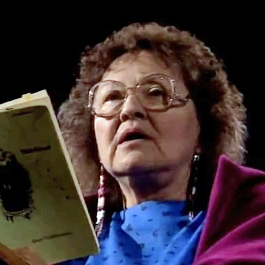Mary TallMountain facts for kids
Quick facts for kids
Mary TallMountain
|
|
|---|---|
 |
|
| Born |
Mary Demonski
June 19, 1918 |
| Died | September 2, 1994 (aged 76) |
| Nationality | American |
| Occupation | Poet Storyteller |
| Known for | Tenderloin Women Writer's Workshop |
Mary TallMountain (born June 19, 1918 – died September 2, 1994) was a talented poet and storyteller. She had a mixed background, with both Scotch-Irish and Koyukon (Native Alaskan) family roots. Her writings often explored how Christianity and Native beliefs could connect. She also wrote about the challenges she faced in her own life.
Mary was adopted by a white family after her birth mother became very ill. She sometimes faced unfair treatment because of her background. Mary started her career as a legal secretary. But she began writing around age 50, becoming an important voice in the Native American Renaissance. She even owned her own business for a while. Later in life, she helped start the Tenderloin Women Writers Workshop in San Francisco. She lived there until she passed away in 1994.
Contents
Mary TallMountain's Early Life
Mary TallMountain was born on June 19, 1918, in Nulato, Alaska. Her mother was of Russian and Native American heritage. Her father was an American soldier with Irish-Scottish roots. Mary belonged to the Athabascan tribe. This tribe is thought to be one of the first groups to come to Alaska from Asia.
Mary had a younger brother. Their mother was very sick and knew she would not live long. So, she decided to give her children up for adoption. This way, they might have a healthier future. Mary's younger brother stayed with the tribe. But Mary was adopted by a white family, the Randles, who were government doctors.
Growing Up and Challenges
Mary and her new family moved to Oregon. This move was very difficult for her. She was taken away from her homeland, her people, her language, and her culture. She was not allowed to speak her native language. Other white children at school sometimes treated her unkindly.
In the 1930s, the Great Depression hit. This was a time when many people lost their jobs and became poor. Mary and her adoptive family became poor workers and moved to Portland, Oregon. Soon after Mary finished high school, her adoptive father died. When Mary was 19, she married Dal Roberts. Sadly, he died just three years later. Her adoptive mother passed away in 1945 after battling illnesses. After these losses, Mary left Portland, Oregon. She moved to Reno, Nevada, to become a legal secretary.
Her Journey as a Writer
In Reno, Nevada, Mary trained and worked as a legal secretary. She later started her own business, which involved taking notes quickly. In 1968, she was diagnosed with cancer. She fought the illness and got better. However, she lost her business during this time.
After losing her business, Mary moved to a part of San Francisco called the "Tenderloin". This was a neighborhood where many people had lower incomes. She started keeping a journal, just like her adoptive mother had encouraged her to do as a child. Once she began receiving a disability pension, she could focus on her true passion: writing. She also taught and gave readings of her work.
Finding Her Voice
Mary published several works, including "Nine Poems" and "Good Grease." Much of her writing explored important themes. She wrote about the spiritual ideas of both Native and Christian beliefs. She also wrote about how all living things and people are connected to nature. For example, in her poem "Coyotes' Desert Lament," the narrator becomes a coyote. This explores the Native idea that all creatures are linked together.
Mary was diagnosed with cancer a second time in 1978. When she got better, she found her biological father. He was also battling cancer and lived in Arizona. He spent his last few years with Mary.
Later Years and Legacy
An Alaskan poet found Mary and helped her get a grant. This allowed Mary to travel and teach in schools, communities, and even prisons. In 1987, she helped create the Tenderloin Women Writers Workshop. This workshop supported local women in sharing their stories through writing.
In 1992, Mary had a stroke. This made it hard for her to speak or understand language. She stopped doing readings or teaching, but she kept writing. Mary TallMountain passed away on September 2, 1994. Her book, "Listen To The Night," was published in 1995 after her death. A special group was created to keep her writings alive. This group also continued the important causes she believed in.
Mary TallMountain's Books
Mary TallMountain's writings are kept at the Rasmussen Library at the University of Alaska in Fairbanks. This collection includes both her published and unpublished works.
- Listen to the Night, Poems to the Animal Spirits of Mother Earth (1995): This book has over 40 poems about animals and nature.
- A Quick Brush of Wings (1991): A collection of 23 poems and parts of a novel she was working on.
- The Light on the Tent Wall, A Bridging (1990): This book contains 52 poems.
- Matrilineal Cycle (1990): A collection of poems including "The Figure in Clay" and "A Song for My Mother."
- There Is No Word for Goodbye (1990): This book features 19 poems.
- Continuum (1988): Poems like "Chant to the Spirit" and "Celebration at the Cross" are in this collection.
- Green March Moons (1987): This book contains a story called "Green March Moons."
- Nine Poems (1977): A small book with poems such as "Birthing" and "Smell of Rain."

